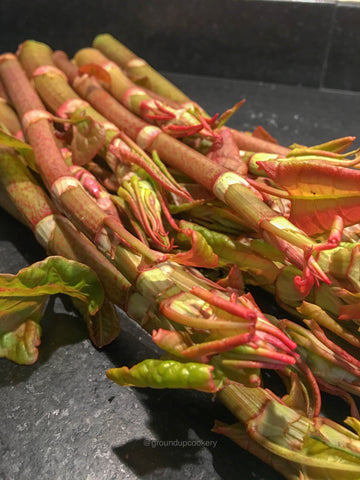
A plant to forage with extreme caution ...
Japanese Knotweed - Fallopia Japonica was introduced to the UK by the Victorians as cattle feed and as an ornamental plant in the 18th century. It is now classed as an invasive weed in the UK to the point that it is an offence to ‘plant or otherwise cause Japanese Knotweed to grow in the wild’. However, it is absolutely delicious! It can grow at an amazing 1.5 metres per month and being an alien species, it is unaffected by the natural controls such as predators and diseases. It certainly is a tasty plant with a multitude of uses, perhaps the best weapon against its spread is to eat it!

The young shoots look a little like red tinged asparagus, make sure you harvest them before they start to get overly fibrous, ideally when they are 15-30 cm in length and before the leaves start to form properly. The flavour is very similar to rhubarb, and like rhubarb contains fairly high levels of oxalic acid. There are many uses for the plant and the hollow stems lend themselves to a variety of uses and methods. They can be roasted, steamed or brushed with oil and cooked on the BBQ. We like to eat it steamed with rosebay willow herb shoots and topped with a sprinkle of cep powder and a drizzle of seaweed butter. I recently gently poached some 20cm lengths in a sugar syrup and will stuff them with sweetened cream cheese flavoured with orange and poppy seeds.

The chopped stems can be used in most ways you would use rhubarb, stew it and pass it through a fine sieve and make fruit leather, make jam, chutney or compote and I have even infused some in a bottle of vodka (thanks Mark at Galloway Wild Foods for that tip!)
A couple of cautionary notes, Japanese Knotweed is a plant that local authorities are at war with and many inject the stems or spray the plant with toxic chemicals. If you are going to harvest this plant make sure you know it has not been treated. It also has a reputation for growing on waste ground or brown field sites that many other species could not tolerate due to high pollution levels that the plant may absorb, be aware of where you harvest it. Finally, remember to dispose of all scraps properly. I usually boil any scraps till they are mushy before feeding to my chickens. It spreads easily and can regenerate from a piece as small as your thumb nail so harvesting and disposal needs to be done with extreme caution. Never put it in your compost heap uncooked.
We could help in the battle against this highly invasive species in a sustainable and environmentally friendly way. Let’s learn from the efforts made to control the spread of other invasive species such as the Lion Fish in the Caribbean and the King Crab in Norway by encouraging more people to add this plant to their diet.


What a great post. Really interesting and I will definitely try this as someone down the road has some.